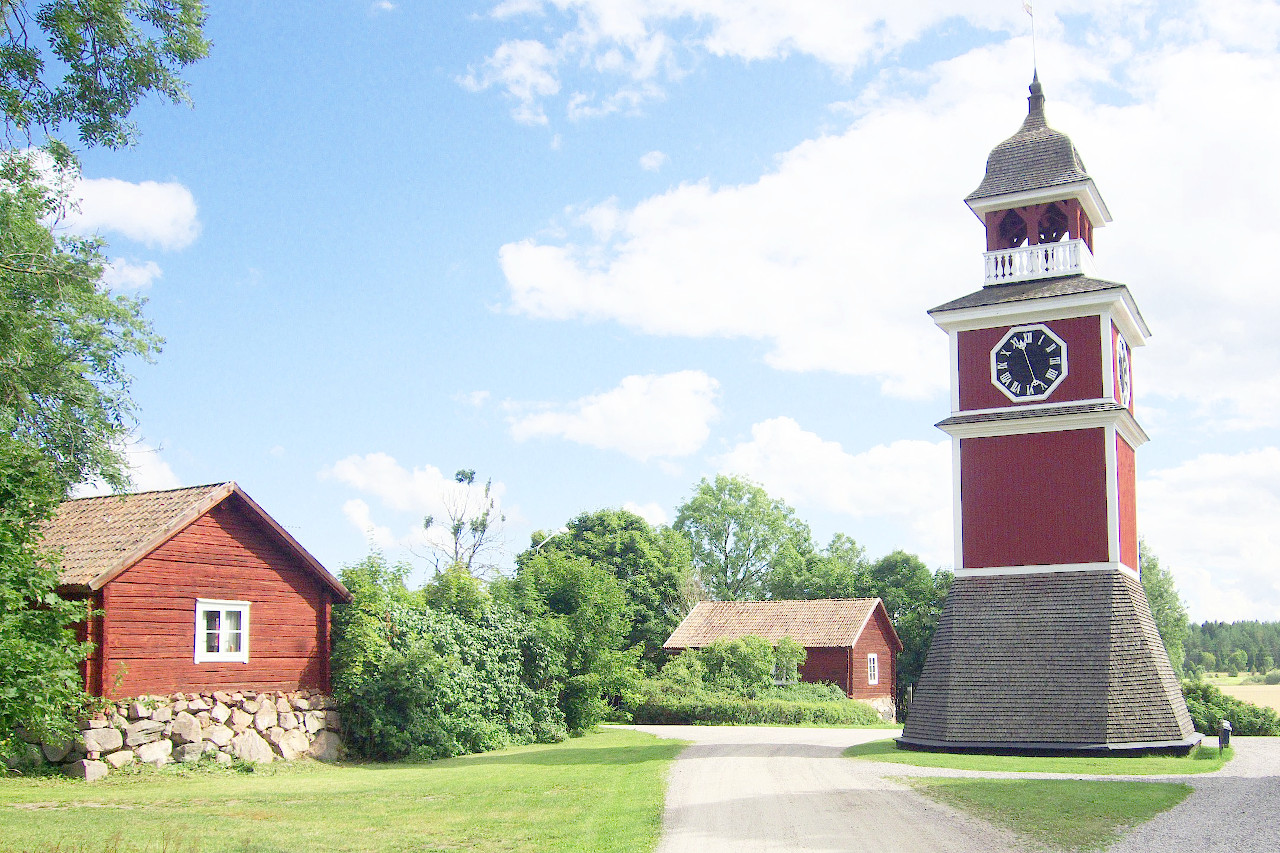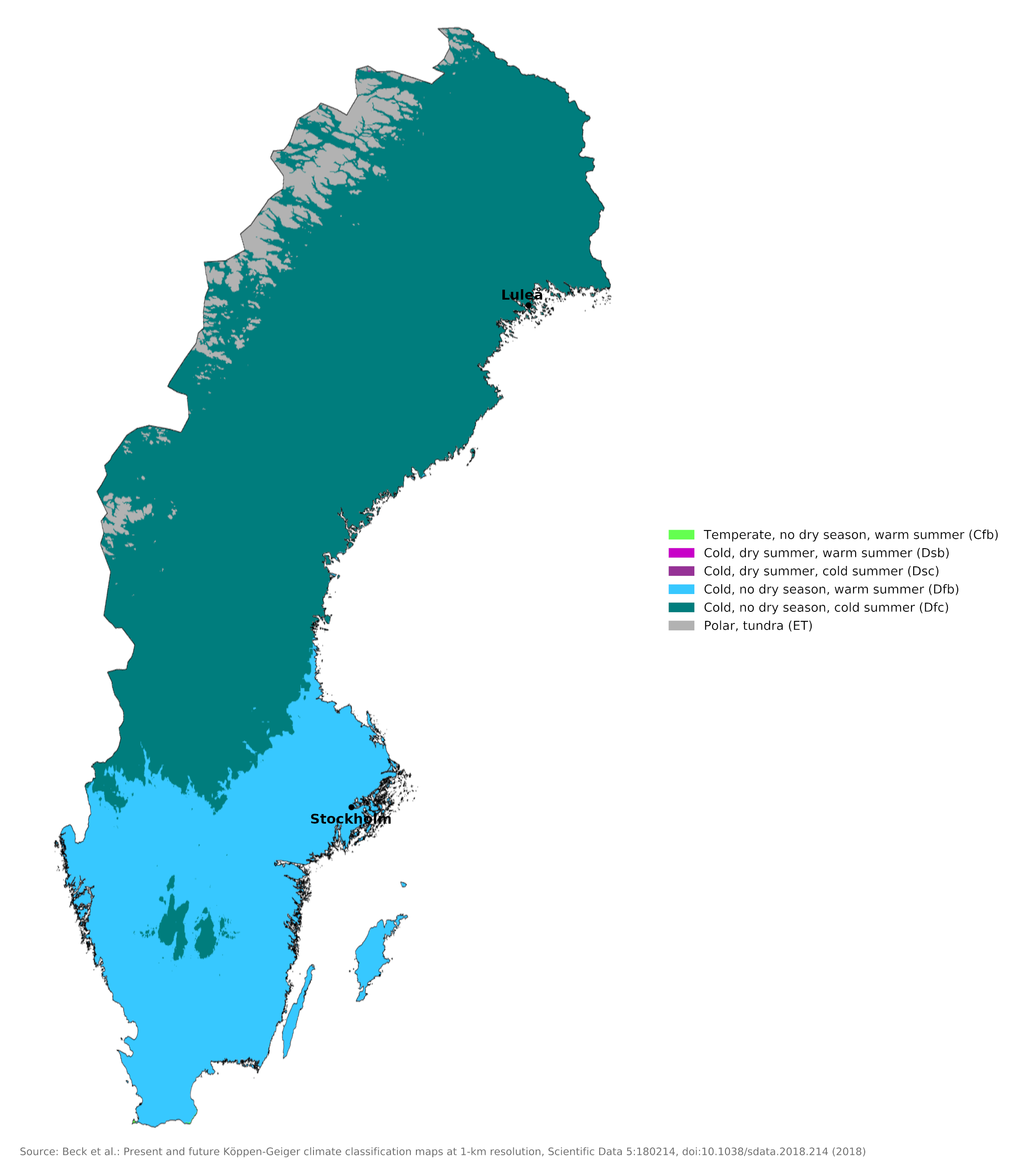The Climate of
Sweden
 Falu red bell tower in Uppsala County
Falu red bell tower in Uppsala County
Climate Map
 Climate map of Sweden
Climate map of Sweden
What is the climate of Sweden like?
Sweden is located on the Scandinavian Peninsula in Northern Europe, between the countries of Norway and Finland. Most of Sweden has a typical continental climate, however this is modified by the North Atlantic Current and the prevailing westerly winds. Therefore, there is a moderate to large temperature range between summer and winter, with the exception of the southwest of the country from Gothenburg to Malmö, where winter temperatures are elevated by an open ocean that rarely freezes over. The enclosed waters of the Baltic Sea often freeze completely or partially in winter; As a result, the east coast of Sweden is much colder, especially in the north where the waters of the Gulf of Bothnia freeze over every winter.
The climate in northern and southern Sweden is very different: the north has a winter of more than seven months and a summer of less than three months, while Skåne in the south has a winter of about two months and a summer of about two months has more than four. The increasing shortening of summer to the north is partly compensated by comparatively high summer temperatures, longer days and high amounts of sunshine; the significant cloud cover in winter reduces heat loss through radiation. North of the Arctic Circle at 66°N there is 24 hours of sun and 24 hours of arctic twilight in midsummer and midwinter.
Temperatures are surprisingly similar across much of the country in midsummer. The long summer days help raise temperatures in the north, so on fine days temperatures here can be as high as in the south. However, due to the generally changeable Swedish summer weather, visitors should not expect nice weather every day. A wet, cool period in summer in northern Sweden can be pretty miserable.
In winter, the average temperature in southern Sweden is -1°C (30°F). In summer, the average temperature there is 19°C (65°F). Norrland (Northern Sweden) has a much colder winter, with a winter season lasting up to eight months, with snow remaining on the ground for around six months. Except in the higher mountains, precipitation is relatively low and tends to be greater in summer than in winter. North of Stockholm much of the winter precipitation falls as snow.
The country can be roughly divided into two climatic regions: central and southern Sweden; and northern sweden—including low-lying shores of the Gulf of Bothnia.
Central and Southern Sweden
Including the cities of Uppsala, Göteborg, Stockholm, Jönköping, Helsingborg, Malmö.
This is the part of the country roughly south of a line from the Oslofjord to Uppsala on the east coast. Much of this area is low lying with numerous lakes. It is the most densely populated and agriculturally productive part of the country. Although winters are fairly cold and shorter than in the north, summers are relatively warm. Rainfall is nowhere heavy; Most rain falls in summer and early fall, and much of winter precipitation falls as snow. In some winters the snow cover can be prolonged and ports on the east coast have to be kept clear with icebreakers. Snow falls an average of 60 days in Stockholm, but it doesn't last as long on the west coast. Summer temperatures are similar to southern England but there are more hours of sunshine than in England. See the climate of Stockholm.
| Climate data for Stockholm (1991-2020) | |||||||||||||
|---|---|---|---|---|---|---|---|---|---|---|---|---|---|
| Month | Jan | Feb | Mar | Apr | May | Jun | Jul | Aug | Sep | Oct | Nov | Dec | Year |
| Average high °C (°F) | 1.0 (33.8) | 1.2 (34.2) | 4.7 (40.5) | 10.7 (51.3) | 16.5 (61.7) | 20.8 (69.4) | 23.6 (74.5) | 22.1 (71.8) | 16.6 (61.9) | 10.1 (50.2) | 5.4 (41.7) | 2.5 (36.5) | 11.3 (52.3) |
| Daily mean °C (°F) | −1.0 (30.2) | −1.0 (30.2) | 1.6 (34.9) | 6.3 (43.3) | 11.4 (52.5) | 15.7 (60.3) | 18.7 (65.7) | 17.7 (63.9) | 13.1 (55.6) | 7.7 (45.9) | 3.6 (38.5) | 0.6 (33.1) | 7.9 (46.2) |
| Average low °C (°F) | −2.9 (26.8) | −3.2 (26.2) | −1.1 (30.0) | 2.6 (36.7) | 7.1 (44.8) | 11.6 (52.9) | 14.8 (58.6) | 14.2 (57.6) | 10.2 (50.4) | 5.5 (41.9) | 1.9 (35.4) | −1.2 (29.8) | 5.0 (41.0) |
| Average precipitation mm (inches) | 37.0 (1.46) | 29.4 (1.16) | 27.3 (1.07) | 29.2 (1.15) | 34.0 (1.34) | 61.7 (2.43) | 61.5 (2.42) | 66.2 (2.61) | 53.3 (2.10) | 51.4 (2.02) | 47.6 (1.87) | 47.8 (1.88) | 546.4 (21.51) |
| Average snowfall cm (inches) | 23.3 (9.2) | 25.6 (10.1) | 18.1 (7.1) | 5.9 (2.3) | 1.1 (0.4) | 0.0 (0.0) | 0.0 (0.0) | 0.0 (0.0) | 0.0 (0.0) | 1.8 (0.7) | 6.6 (2.6) | 20.3 (8.0) | 102.7 (40.4) |
| Source: Swedish Meteorological and Hydrological Institute | |||||||||||||
Northern Sweden
Including the cities of Sundsvall, Härnösand, Örnsköldsvik, Östersund, Umeå, Skellefteå, Luleå, Gällivare, Kiruna
Here, northern winters get longer and colder. The short summers are surprisingly warm for the high latitudes near or north of the Arctic Circle. When the weather is fine, winter temperatures drop very low, while summer temperatures can rise surprisingly high. However, most of the area has a severe winter climate with short, changeable summers.
Precipitation is fairly light near the coast, but snow can lie on the ground for up to 120 days, and this number increases inland with elevation. In the high mountains, the snow cover remains all year round. Summers are sunnier and less cloudy than in the mountains along the Norwegian border. See the climate of Luleå.
| Climate data for Luleå (2002–2020) | |||||||||||||
|---|---|---|---|---|---|---|---|---|---|---|---|---|---|
| Month | Jan | Feb | Mar | Apr | May | Jun | Jul | Aug | Sep | Oct | Nov | Dec | Year |
| Average high °C (°F) | −5.2 (22.6) | −4.5 (23.9) | 0.2 (32.4) | 5.6 (42.1) | 12.3 (54.1) | 17.4 (63.3) | 20.5 (68.9) | 18.7 (65.7) | 13.4 (56.1) | 5.9 (42.6) | 0.6 (33.1) | −2.0 (28.4) | 6.9 (44.4) |
| Daily mean °C (°F) | −9.1 (15.6) | −8.7 (16.3) | −4.2 (24.4) | 1.5 (34.7) | 7.7 (45.9) | 13.3 (55.9) | 16.6 (61.9) | 15.0 (59.0) | 9.9 (49.8) | 2.9 (37.2) | −2.4 (27.7) | −5.6 (21.9) | 3.1 (37.5) |
| Average low °C (°F) | −13.0 (8.6) | −12.9 (8.8) | −8.5 (16.7) | −2.6 (27.3) | 3.1 (37.6) | 9.1 (48.4) | 12.6 (54.7) | 11.2 (52.2) | 6.3 (43.3) | −0.2 (31.6) | −5.4 (22.3) | −9.1 (15.6) | −0.8 (30.6) |
| Average precipitation mm (inches) | 57.9 (2.28) | 36.8 (1.45) | 30.2 (1.19) | 31.3 (1.23) | 45.1 (1.78) | 65.8 (2.59) | 67.6 (2.66) | 69.5 (2.74) | 66.0 (2.60) | 52.9 (2.08) | 52.6 (2.07) | 56.3 (2.22) | 632 (24.89) |
| Average extreme snow depth cm (inches) | 55 (22) | 72 (28) | 75 (30) | 64 (25) | 0 (0) | 0 (0) | 0 (0) | 0 (0) | 0 (0) | 5 (2.0) | 16 (6.3) | 30 (12) | 79 (31) |
| Source: Swedish Meteorological and Hydrological Institute | |||||||||||||
When is the best time to visit Sweden?
The best time for a summer holiday is May–September, when the weather is warm and sunny, never humid. Enjoy the midnight sun in Lapland in June and July, but also go there later, in September, for lovely fall colors and fewer mosquitoes. For winter sports, February and March are the best months, but you can ski in northern Lapland virtually all year round.
References
- E. A. Pearce, Charles Gordon Smith, (1990) The Hutchinson World Weather Guide, John Murray Press. ISBN 1859863426
- Timothy L. Gall, (ed.), (2003), Worldmark Encyclopedia of the Nations, Eleventh Edition, Thomson Gale
- Hugh Chisholm, (ed.), (1911), Encyclopædia Britannica, Eleventh edition, Cambridge University Press
The Climate of
Sweden

In summary:
Sweden has a continental climate, but the maritime influence of the Atlantic raises temperatures higher than its northerly latitude would suggest. Stockholm averages -1°C (30°F) in February and 19°C (65°F) in July. Northern Sweden has much colder winters, with a winter season that extends for up to eight months, but even here the short summers see fairly high temperatures.
Annual rainfall is moderate averaging around 600 to 900 mm (23 to 35 in), and is heaviest in the southwest and along the frontier with Norway. There is considerable snowfall, and in the north snow remains on the ground for about half the year.